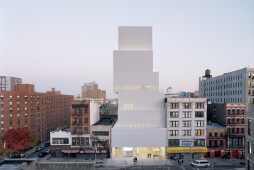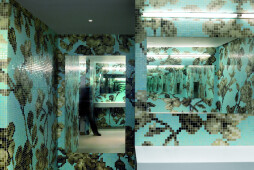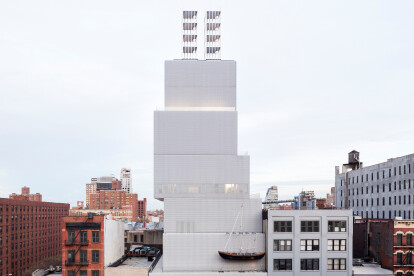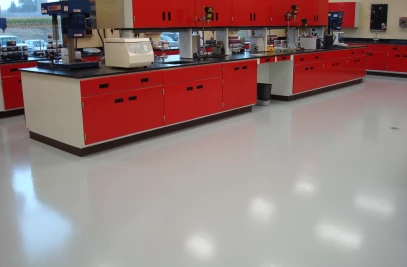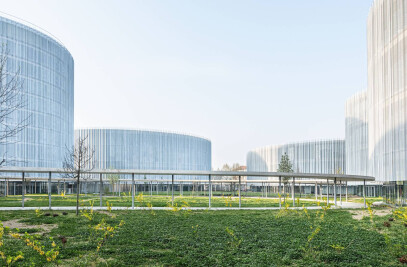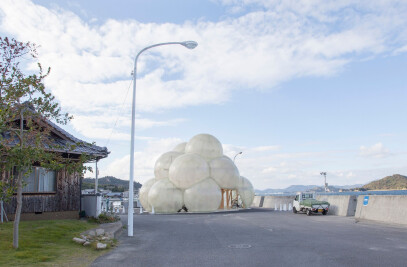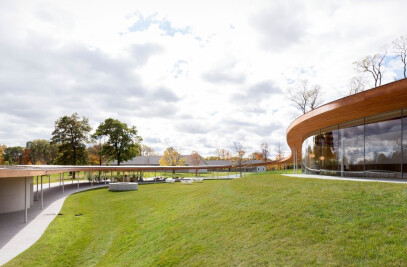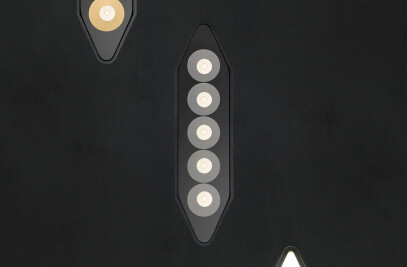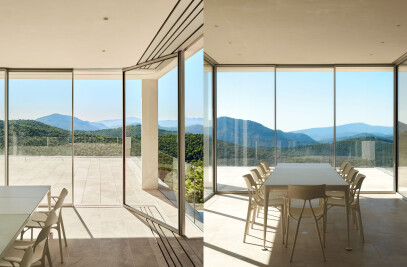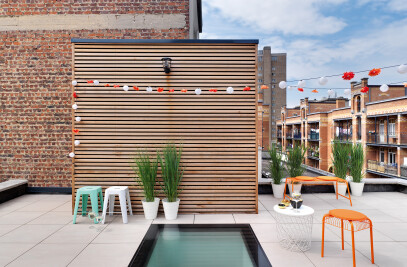The New Museum of Contemporary art is an urban infill in Downtown Manhattan. Given such a dense urban setting, stacking museum spaces might easily have led to an introverted mass, but by shifting the volumes in relation to each other we opened the building up and the museum started to interact with its surroundings. This shifting allows for skylights, terraces, and variation, all while maximizing wall space and keeping within the zoned building envelope. As the relation between core and envelope vary, different lighting conditions and proportions arise.
| Element | Brand | Product Name |
|---|---|---|
| Epoxy floor | Tennant Flooring | |
| Faucets | VOLA | |
| Skylight glass | Vitro Architectural Glass | |
| Aluminium curtain wall mullion | CRL | |
| Toilets | TOTO | |
| Lighting | Bartco Lighting |
In December 2007, the New Museum opened on the Bowery with a building designed by acclaimed architects Sejima + Nishizawa/SANAA. SANAA conceived of the Museum as a sculptural stack of rectilinear boxes shifted off-axis around a central steel core. This innovative approach produced a variety of open, fluid, and light-filled spaces, each with a different character. At the heart of the New Museum’s seven-story building are three floors of column-free galleries. Each is distinguished by a different ceiling height and unique location of skylights created by the setbacks where the stories shift. The ground floor of the new facility, the Marcia Tucker Hall, includes a glass-walled gallery, a café, and the renowned New Museum Store. The New Museum also has a 182-seat theater for performances and events, a fifth-floor Education Center, and a top-floor Sky Room for public and private events. The use of industrial materials is in keeping with the commercial character of the Bowery, and SANAA has used them in a way that is at once beautiful and rough, gritty and elegant. There is a deliberate openness to the building, with its glass storefront, and a desire for structural transparency making the building’s materials visible, from the steel to the ductwork to the freight coming in and out of the loading bay. The exterior is clad in a seamless, anodized aluminum mesh, which emphasizes the volumes of the boxes while dressing the whole building in a delicate, softly shimmering skin. The structure appears as a monolithic form, but also a mutable and dynamic one which is animated by the changing light of the day—a perfect metaphor for the ever-changing nature of contemporary art.
The New Museum is the only museum with the mission to promote new art and new ideas, and the only museum in New York City devoted exclusively to international contemporary art. Founded in 1977, the New Museum was conceived as a center for exhibitions, information, and documentation about living artists whose work did not yet have wide public exposure or critical acceptance. It has a unique history of being founded by a curator— Marcia Tucker—who had neither personal resources nor a collection, just abundant resourcefulness and a passion for living culture. At its inception, the Museum lay somewhere between a grassroots alternative space and a major museum devoted to proven historical values. The deliberate paradox was embodied in the name “New Museum” and in Tucker’s daring vision and combative idea to present new art in a critical and scholarly context.
The New Museum has evolved over the past three decades, from its humble beginnings in a one-room office on Hudson Street in 1977, to a gallery space in the New School later that year, to its expansion and relocation to SoHo in 1983, to the inauguration of its first freestanding, dedicated building in 2007. Our culture has also evolved during this time and contemporary art is more widely embraced today. The New Museum has an important and influential legacy and mission to keep breaking new ground. A site of ongoing experimentation and questioning of what art and institutions can be in the twenty-first century, the New Museum continues to look to the future through programming that is open, fearless, and alive.
Products Behind Projects
Product Spotlight
News

Norman Foster Foundation launches global competition to revitalize Kharkiv’s iconic Freedom Square
As Kharkiv continues to recover from the effects of the ongoing conflict in Ukraine, the Norman Fost... More

Daisuke Yamashita Architects designs unconventional house with “impromptu appearance” in Tokyo
Tokyo-based Daisuke Yamashita Architects has designed a home for a couple and their two children in... More

Archello houses of the month - September 2024
Archello has selected its houses of the month for September 2024. This list showcases 20 of the... More

Eden Dock offers buoyant green oasis in heart of London’s Canary Wharf
A green oasis has been unveiled in the heart of London’s Canary Wharf: Eden Dock is a buoyant... More

Design for Weald House in English countryside reimagines agricultural barn vernacular
English architectural studios Mailen Design and Peter Bradford Architects worked in collaboration on... More

Swiss school expansion by LOCALARCHITECTURE features a flexible wooden framework and earth brick walls
Lausanne-based LOCALARCHITECTURE has designed a new building for the Rudolf Steiner School c... More

MVRDV and Buro Harro complete lush Buitenplaats Koningsweg master plan on former WWII military base
On the outskirts of Arnhem in the eastern Netherlands, a surprising new master plan has come to frui... More

Centre Culturel Nelson Mandela by Jean-Pierre Lott Architecte fluidly integrates with its historic urban context
In Pantin, France, the Nelson Mandela cultural space by Jean-Pierre Lott Architecte is located in th... More

